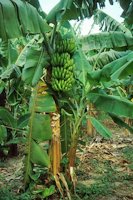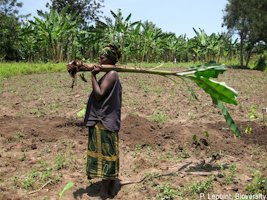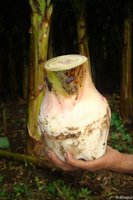Banana Propagation From the Horticultural Sciences Department, Florida Cooperative Extension Service Institute of Food and Agricultural Sciences, University of Florida The most common propagation material is suckers, or pieces of the rhizome. There are 3 types of suckers: maidenhead, a large non-fruiting pseudostem (plus roots and some rhizome); sword sucker (Fig. 2), a sucker attached to the original (mother) rhizome with narrow sword-like leaves, and; a water sucker (Fig. 2), a sucker next to but only superficially attached to the mother rhizome with broad leaves. Water suckers produce inferior fruit and are therefore not recommended. Large sword suckers and maidenheads are the preferred planting material. 1
Fig. 1. A fruit-bearing parent plant (left) and a ratoon sucker (right) Fig. 2. Sword sucker (left) and water sucker (right) A sucker is a lateral shoot that develops from the rhizome and emerges from the soil usually near the parent plant. It is a form of asexual, or vegetative, reproduction, that makes the banana plant perennial. Suckers emerge and ensure a more or less continuous supply of shoots, each capable of producing an inflorescence. They have been used as planting material since the early days of domestication by severing them from the mat and transplanting them to a new location. 2 The sucker appears above the soil and its state is characterised in part by its appearance. Initially, suckers have only leaf sheaths without a midrib or lamina. In horticultural terminology they are called peeper suckers. Some remain at this stage without further growth. Others continue to grow and produce leaves with a midrib and a very narrow lamina. They are then called sword suckers (Fig. 2). Sword suckers gradually produce leaves whose laminae are broad and of the adult form. The sucker selected to replace the parent plant is called the follower or ratoon. A full grown sucker bearing foliage leaves is called a maiden sucker. Sometimes, ratoon suckers that have not fruited are referred to as maiden suckers, although this term is poorly defined, and it can be difficult to determine whether a sucker at this stage is vegetative or contains an unemerged bunch. 2
Fig. 3. Woman farmer carrying a banana sucker for transplanting in a field Fig. 4. Pared sucker Sword suckers should be removed from vigorous clumps with a spade when they are 4–5 ft (1.2–1.5 m) tall (video: Collecting Sword Sucker). The largest leaves are cut off, leaving only the youngest or none at all. Suckers should have many healthy roots, without symptoms, such as nodulations and internal lesions, of nematode or borer damage. The pseudostems of maidenhead suckers are cut down to 8 inches (20 cm) high and the remaining rhizome is cut into "seed" pieces for planting. In the event that healthy propagating material is not available, the sucker is cut off and its rhizome is pared of all damaged roots and dark tissue (video: Cleaning of the corm), or is cut into pieces containing only white, healthy tissue and a few buds. If nematodes are a problem in the area, it is strongly recommended that nematode-free or hot water treated propagating material be used. 1 Lateral buds may survive on sections of the rhizome after the aerial stems of earlier generations have decayed. Suckers that arise from these lateral buds usually have a small rhizome and broad leaves. They are called water suckers and their connection to the rhizome is often structurally weak. For this reason, water suckers are not suitable for selection as a ratoon to continue the life of the mat into the next generation. 2 Bananas are commercially propagated from meristems by tissue culture. The advantage of this system is that plants are uniform and free of nematodes and most diseases. The disadvantage is the time it takes for small plants to be grown to a sufficient size for sale from the nursery and in some areas their lack of availability. 1 In south Florida, March, April, and May are the best months for planting if irrigation is available. Otherwise planting should be delayed until the onset of the rains in June. Planting holes should be large (3-ft-wide by 2-ft-deep; 0.9 m x 0.6 m) if possible. Addition and mixing with the native soil of completely composted organic matter or a sand-peat moss mixture may be desirable. Plants should be watered-in thoroughly, and a heavy layer of mulch placed around the suckers immediately after planting will assist in keeping the soil moist and will suppress weeds. 1 Further Reading Bananas, plantains and other species of Musaceae Protocols and standards for vegetatively propagated crops, Food and Agriculture Organization of the United Nations Back to Banana Page |
||||||||||||
| Bibliography 1 Crane, Jonathan H., and Carlos F. Balerdi. "Bananas Growing in the Home Landscape." Dept. of Horticultural Sciences, UF/IFAS, HS10, Original pub. Oct. 1971 as FC-10, Revised Jan. 1998, Dec. 2005, Oct. 2008, and Nov. 2016, Reviewed Dec. 2019, AskIFAS, edis.ifas.ufl.edu/mg040. Accessed 24 Mar. 2017, 3 Aug. 2020. 2 Vezina, Anne. "Sucker." Musapedia, the banana knowledge compedium, 30 Jan. 2018, www.promusa.org/Banana+sucker#Types_of_suckers. Accessed 23 Apr. 2018. Videos from the Florida/IFAS Tropical Research and Education Center in Homestead, FL. by permission of Dr. J. Crane Professor and Tropical Fruit Crops Specialist. Photographs Fig. 1 Chaput, Pascal. "Healthy looking banana sucker that has been pared (trimmed of its roots and outer leaf sheaths) in preparation for planting." Consultora para la Comunicacion en el Campo, Aug. 2010, Musapedia, the banana knowledge compedium, (CC BY-NC-SA 4.0), www.musarama.org/en/image/pared-sucker-221.html. Accessed 23 Apr. 2018. Fig. 2 Lepoint, Pascale. "Woman farmer carrying a banana sucker for transplanting in a field. Most smallholder farmers use suckers as planting material." Bioversity International, March 2011, Musapedia, the banana knowledge compedium, (CC BY-NC-SA 4.0), www.musarama.org/en/image/woman-holding-a-banana-sucker-34.html. Accessed 23 Apr. 2018. Fig. 3 Staver, C. Bioversity International, Musapedia, the banana knowledge compedium, (CC BY-NC-SA 4.0), www.musarama.org/en/image/pared-sucker-221.html. Accessed 23 Apr. 2018. Fig. 4 Roux, N. "A fruit-bearing parent plant (left) and a ratoon sucker (right)." Biodiversity International, Musapedia, the banana knowledge compedium, (CC BY-NC-SA 4.0), www.promusa.org/Banana+sucker#Types_of_suckers. Accessed 23 Apr. 2018. Published 24 Mar. 2014 LR. Last update 23 Apr. 2018 LR |
||||||||||||




